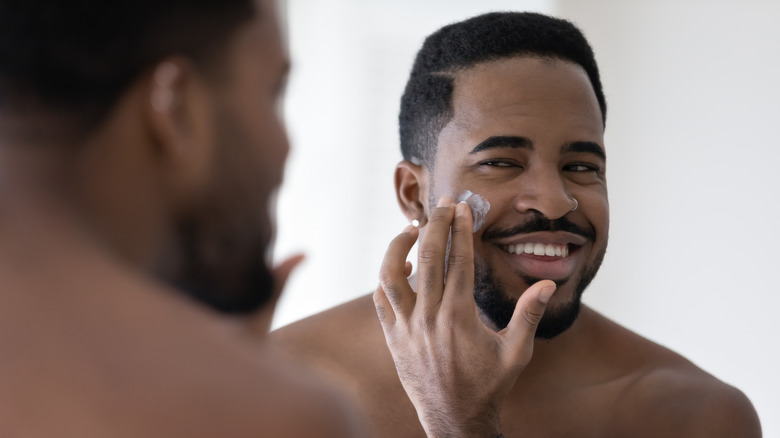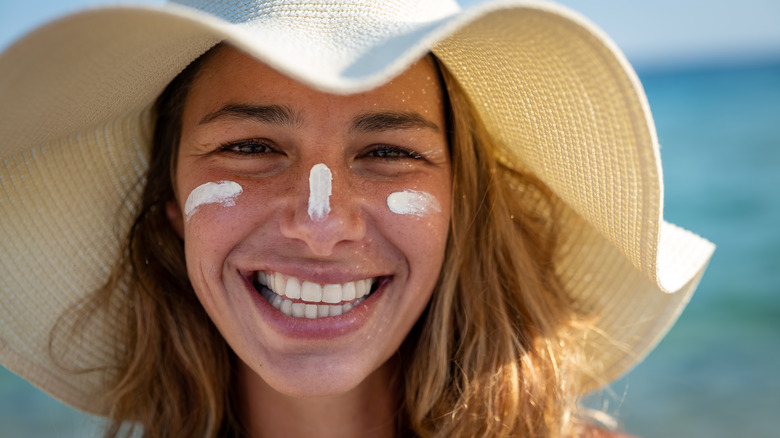Here Is Exactly How Much Sunscreen You Should Be Applying To Your Face
Summer is a time of adventure, laughs, and plenty of fun in the sun. And along with those long days out soaking in the vibes with friends comes the possibility of absorbing the sun's harmful rays. If you're a skincare lover or someone who is obsessed with sun protection, then you already know the importance of applying sunscreen daily. But did you know that, according to the American Academy of Dermatology (AAD), less than 50% of people are using the recommended amount of sunscreen when applying it?
Most consumers assume the best sunscreen available to them is whichever has the highest SPF, but that's not always the case. As dermatologist Dr. Dennis Gross recently told our sister site The List, most people apply their sunscreen incorrectly without knowing it. "[Many people] aren't applying a sufficient amount of sunscreen, and/or aren't reapplying as frequently as they need to be to protect their skin," Dr. Gross says. Along with infrequency of application and using the wrong amount of product, Dr. Gross pointed out that the ingredients that make-up your sunscreen make more of a difference in the level of protection your skin receives.
These tiny changes to your sunscreen routine might seem inconsequential but experts agree that they add up over time. So, what else do the experts wish consumers knew about applying sunscreen? Let's break down everything there is to know about how much sunscreen you should be using, along with the best brands to use for your skin type.
How much sunscreen should you be applying?
As board-certified dermatologist Ranella Hirsch tells Allure, you'll need to use at least half a teaspoon of sunscreen (about the size of a nickel) for your face and neck to reap the benefits of the full protection labeled on the product. If you're using a face stick sunscreen, you'll want to do at least four passes over your face, allowing the product to settle into the skin between applications. You'll also want to pay special attention to sensitive areas like the back of your neck, tops of your ears, and your under eye area.
As for how often to reapply your sunscreen, the experts at Johns Hopkins Medicine recommend reapplying your sunscreen every two hours, especially after swimming or sweating. If you work indoors and sit away from windows, you may not need to reapply as often. As a general rule of thumb, you'll want to reapply more often the longer you're directly exposed to the sun. Applying your sunscreen after using a moisturizer when doing your daily skincare routine is the most effective, and be sure to allow your moisturizer to dry completely before adding your sunscreen to avoid pilling.
How much SPF is enough?
Choosing the right SPF (sun factor protection) level for your skin type can be one of the most confusing factors when purchasing sunscreen. During the summer when the sun is at its highest and hottest, you'll want to err on the side of caution. "As a rule of thumb, do not use less than SPF 30. In the summer months use SPF 50 and reapply every few hours throughout the day if you are outside in the sunshine," Dr. Sophie Shotter tells Harper's Bazaar.
SPF ratings are determined based on how much of the sun's burning rays the product is estimated to allow through to the skin, so people who burn faster will need higher SPF sunscreen to protect their skin from UV rays. In addition to choosing a sunscreen with the right SPF to protect your skin, experts suggest choosing a broad-spectrum sunscreen that also protects the skin from UVA and UVB rays (via Well + Good). UVA protects your skin from the sun's rays that cause premature aging and UVB protects you from the rays that cause burning. Most broad-spectrum sunscreens on the market will check all of these boxes.
How to choose the right sunscreen
There are a few other choices to make when choosing the right sunscreen. For starters, pregnant folks or anyone who is nursing should be extra careful about the sunscreen they choose. Overall, most sunscreens are safe to use during pregnancy so long as you avoid any that contain oxybenzone, octinoxate, and vitamin A, as well as its byproducts, including retinol, retinaldehyde, adapalene, and tretinoin (via Today).
If you're the outdoorsy type or you're planning to spend some time in the water, you'll want a water-resistant sunscreen that maintains its protection even when you're swimming or sweating. And if you're taking a dip in the ocean, the FDA recommends wearing a "reef-safe" sunscreen that won't cause damage to the local ocean wildlife (via Travel + Leisure). These sunscreens specifically avoid using the two main chemicals known to harm marine life: oxybenzone and octinoxate, which makes them safe to wear in the ocean.
Once you've determined what you need your sunscreen to do, it's time to choose a brand that works with your skin's needs, not against them. If you have dry skin, you'll want a sunscreen with hydrating ingredients, such as glycerin and ceramides. People with oily skin should avoid mineral sunscreens and opt for a chemical sunscreen instead to prevent skin aggravation. And if you have sensitive skin, including eczema flare-ups, rosacea, or fragrance allergies, mineral sunscreens with titanium dioxide or zinc will work best (via Forbes).



